From the Hendon Times and Guardian, Friday, March 31st, 1939:
CORRESPONDENCE.
THEY CALL IT MUTTON BROOK!
TO THE EDITOR
Sir, - How much longer is it to be before something is done about that unsightly and odiferous storm water drain called for some inexplicable reason Mutton Brook?
It borders (at the point that interests me most, anyhow) two presumably progressive boroughs – Hendon and Finchley – and it comes under the administration of another presumably progressive Council, the Middlesex County Council. But actually it seems to be “nobody’s baby.”Perhaps once upon a time it was one of those musical brooks in which poets delight. But that must have been long ago. Now it is an offence to nearly every sense. And the only life it could possibly support is bacteriological.
Finchley has a direct interest in Mutton Brook, because the brook runs through or alongside some of its many otherwise charming open spaces. Hendon ought to be interested because at some points one bank is Hendon territory. If the County Council of Middlesex is interested it has yet to prove that interest.To householders in Hurstwood Road, whose gardens back on this brook, it has for years been a cause of concern. It is continually stealing chunks of our gardens because it is no longer adequate for the conduit of the increased and increasing volume of road water that is poured into it.And during the last month garden disturbances have become in consequence so serious that that every successive morning we look out of our bedroom windows half expecting to see that each of us has got his neighbour’s garden.
The Middlesex County Council appears to think that we householders are to blame for allowing the drain to pinch our banks. It says we can legally be called upon to make good these banks. Which presumably means that we are to descend into the brook bottom with our garden tools and try and put into Hendon ground that has gone into Finchley, or into County Council territory, or into No Man’s Land.
May I appeal to those members of the Councils of Hendon, Finchley and Middlesex County whose eye this may catch, really to try and help us to get something done about this drain? Some members of the two Councils to which we pay rates have been kind and helpful, but there’s a terrific lot of red tape in which everything is tied up.The drain wants widening and concreting, and if it isn’t done very soon it will get completely blocked up by pieces of Hendon and Finchley falling into it.And the Middlesex County Council would probably blame it all on us poor garden(less) owners! – Yours faithfully,
H. G. Perry.
16, Hurstwood Road,
Golders Green.
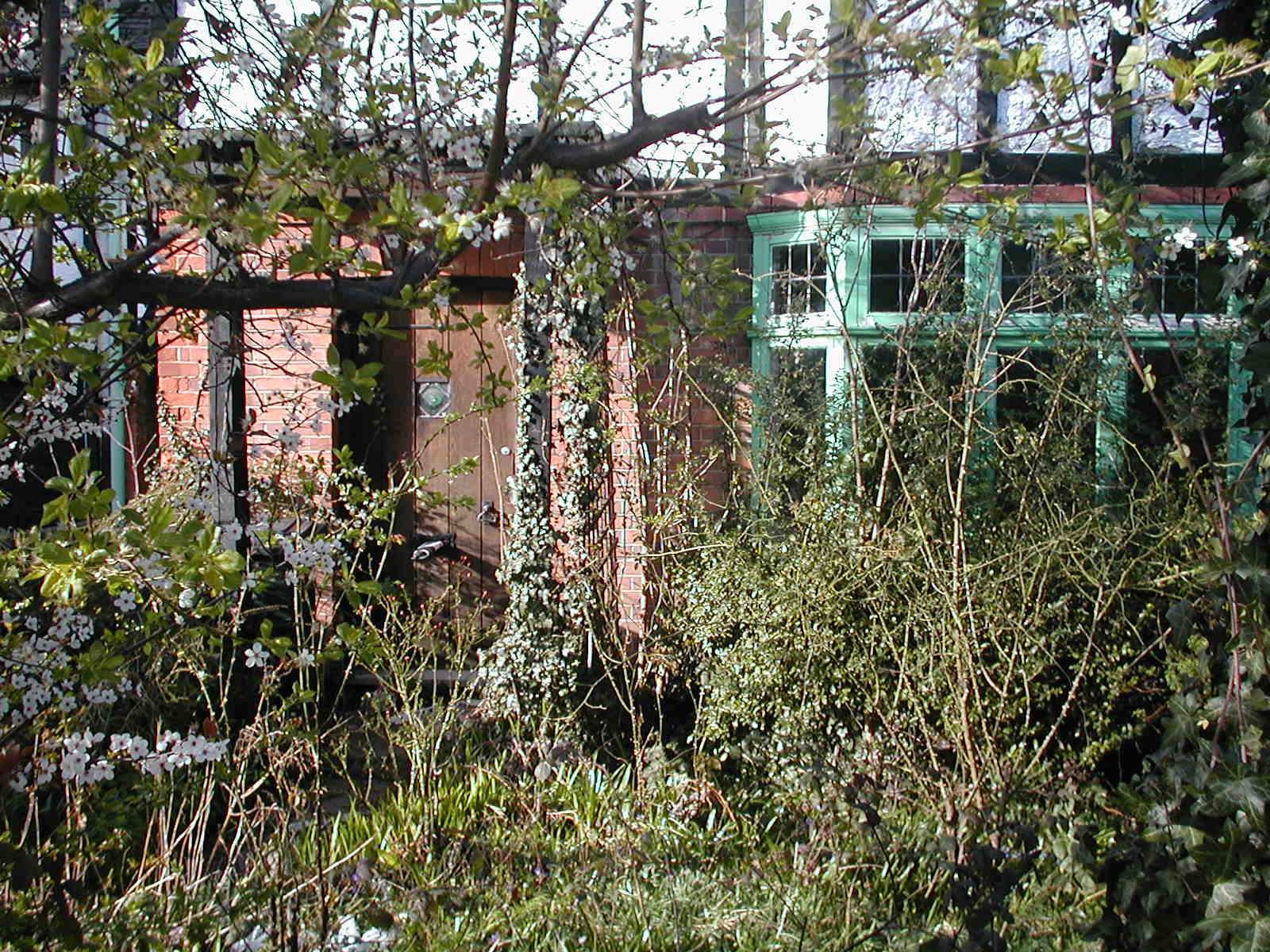
16 Hurstwood Road. Formerly the home of HG Perry,
it was recently investigated by Middlesex County Council''s
Deep Topography Unit
Perry''s problem was exacerbated by an unforseen consequence of major road developments; a drainage runnel had been run down off the Finchley Road into the Mutton Brook to discharge waters that would otherwise have collected on the road surface. This increased the flow of water through the stream, which, in turn, increased the destruction of the riverbank. Fortunately the County Council and Finchley Borough Council were aware of the problem, as the following item, taken from The Finchley Review for June 1937 shows:
Serious erosion of the bank of the Mutton Brook aggravated by the flow from a 48-inch Council Surface Water Sewer, which discharges into the brook near Regent’s Park Road, necessitates expenditure of £8000 with Finchley Council contributing £2000. The work involves straightening the brook for a distance of about 2000 yards.
The 48-inch channel is still visible today as a rise along the asphalt track adjacent to the brook about 20 yards into the green space from the Finchley Road.
The Mutton Brook rises three miles from HG Perry''s former home, in Highgate and Dirthouse Woods. After running due west, between the north face of the Hampstead-Highgate massif and the southward slope of the Finchley Ridge, the Mutton crosses beneath the junction of the North Circular and Finchley Road at Henlys Corner. Its confluence with the Dollis stream marks that river''s name-change to the Brent. On its course alongside the Lyttleton Way and Falloden Way it is joined by several streams rising on the high ground on either side. One, originating on the Hampstead highland somewhere just to the west of where Winnington Road runs down to the main road possibly feeds the little lake hidden in waste land on the old site of Spaniard''s Farm. This stream is conduited for its course and enters the Mutton Brook through a pipe.
Just to the west another stream - this rising to the north of the Brook on the Finchley gravels - enters the brook through a pipe opposite the Lyttleton Playing Fields where Watery Wood used to be.
At least two other steams join the Brook as it flows west and one of these is visible from Falloden Way as it winds through some secondary woodland towards the Mutton Brook. It surfaces opposite Tillingbourne Gardens and so I call it the Tillingbourne, though whether this is correct I don''t know.
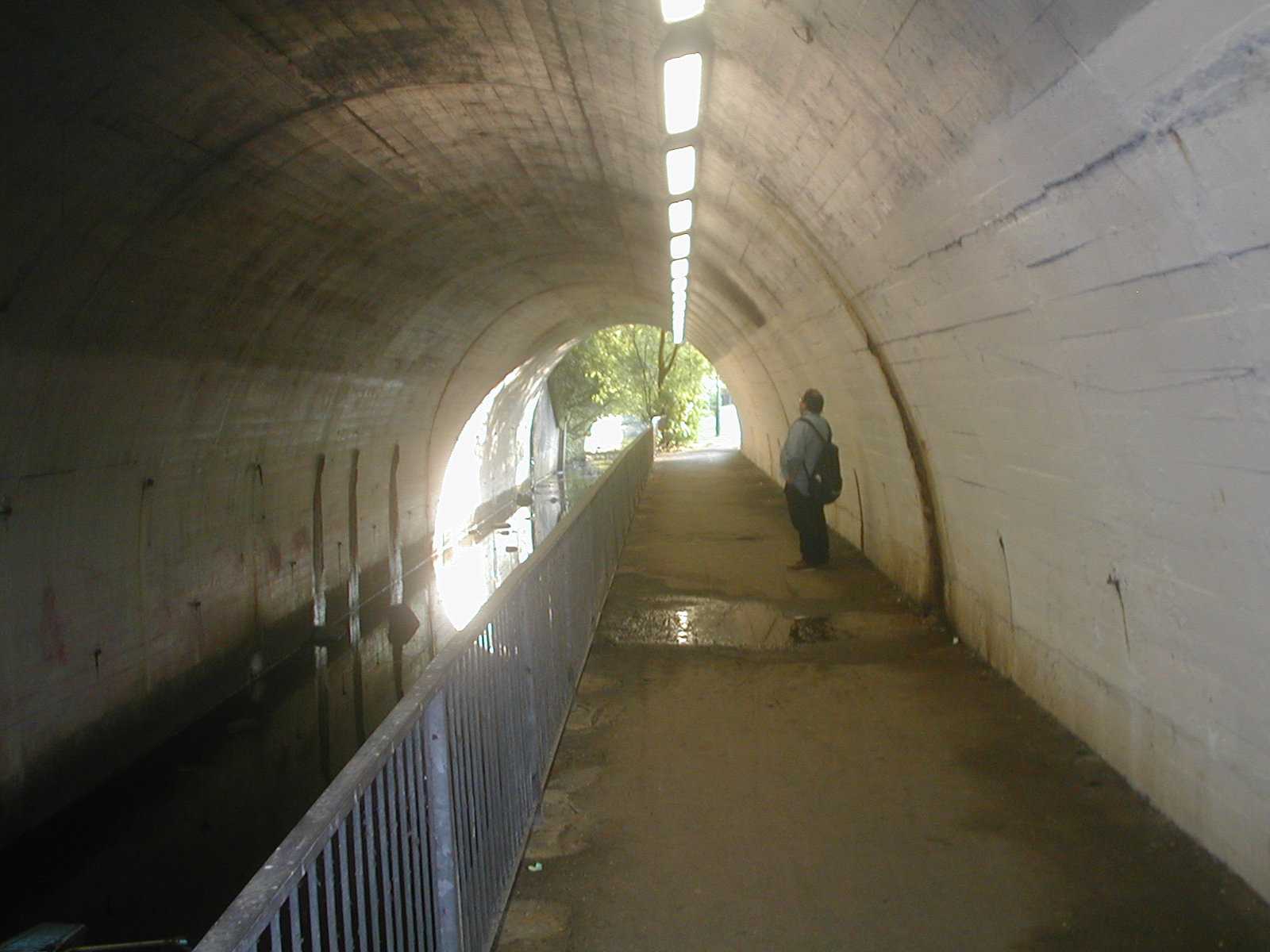
Mutton Brook runs through a tunnel beneath the A406
Descending the slope running down towards the brook from the Finchley Road, from behind the old motor dealers that gave Henly''s Corner its name, is like stepping out of one world and into another. One moment there are buses and trucks, the next a band of green. Ahead run undulating grasslands and indications of civic utility in the form of sheets of lichen-pocked concrete embedded in the sward. Intermittent banks of vegetation run down from the North Circular to the edge of the path following the stream. Amongst the elders and twisted willows are patches of meadow pea and mallow. Birds foot lotus, with its red-edged yellow petals, breaks the green and pale yellow of the grasses.
Ahead, above the tree line are towerblocks over at Hendon. The busy main roads never cease in their roaring while joggers appear along the tracks that undulate through the sculpted hillocks. The intermingling of the urban and the natural creates a curious tension within the landscape. At one point a tree clad walkway leads through to a tunnel lit by striplights. The curve of the tunnel roof is a tantalising example of the "old new" clearly dating from the era of the building of the North Circular which buzzes overhead.
The Hendon and Finchley Times reported, in March 1956, that police sgt. Harry Pike told the East Middlesex Coroner, A.P. Cogswell how he found the body of a new-born baby boy in the brook opposite Falloden Way on the fourth of the month. Think of this next time you walk along the brook and ponder at the massive quantity of material contained in the storage vat of regional memory.
After passing through the tunnel the vegetation changes. A large area of grass is left uncut, as part of some biodiversity initiative, and masses of docks grow here. Numerous ash trees sparkle after the recent rain. At the confluence of Mutton Brook and the Brent is a bridge with ornate ironwork and a path through to Brent Park via ancient Bridge Street. The pond here is reckoned to be very old. On the day I visited it was dense with duckweed. The park has a gloomy air and doesn''t interest me overmuch.
Rats live under the pumping shed down by the brook. I throw a piece of bread towards the hole under the door. A moment later a snub nose emerges. The rat climbs out and helps itself. Another, greyer, emerges from somewhere near where a giant horse chestnut is mounted on its roots above the riverbank. It is chased off by the first rat, which then returns to the bread.
Heading back I study the ecotone formed of the interface between the arterial road and the meadowland. A ditch separates the pavement from the parkland and here ants'' nests abound in the sandy soil; I disturbed one with a stick, tearing of a nodule of earth. The tiny workers struggled to move the pupæ. These small cities are perched on the edge of a vast steely process carrying the rational bipeds to Chingford and Brentford. Silent and diminutive, these creatures know nothing of love and crime, profit and boredom and the other drivers of our technology.
Great leaves of knotweed hang limply along the margin. These seem to be larger than the usual, rather neat Japanese variety. I look to their base, beneath the leaves where the bamboo-like stalks cluster. The cleavers are pale and shrivelled, starved of light, but the brambles still look pretty strong though devoid of flowers.
The yellow-domed pineapple plant grows at one spot. I tear a piece of its delicate leaf and smell it. Its name is well earned. A blackbird checks out the place where I threw some bread to a gang of rooks a few moments earlier. He eats a few crumbs of rye and moves on. Beneath my feet a turbulence is felt as water flows down through runnels into the sewers. Across the road a curious end zone, tacked onto the backs of gardens and dense with ivy stands unvisited. It possibly bares a connection with the waterways. Behind the ivy, packing the soil of the gardens into a terrace against the slope of the valley, there are crumbling vertices of concrete. From when do they date? 1968? 1935? This is one of those null-points of the town; a bottle thrown there in 1978 will remain, unseen, waiting for what?
Back at the junction I enter the area where Henly''s Motors once stood. It is a sort of fortress against the knotweed, sealed by blue hoarding. Successive mounds of rubble have been illegally dumped here and have tampered down the vegetation. The recurring disturbance encourages opportunistic plants, discourages dominants. Ghosts of my childhood, when Henley''s was a feature on the landscape flit amongst the melilot and the spiders'' webs. A solitary teasal lords it over the rest. Standing amidst fragments of breeze block the metallic-looking plant waits. A drowned wasp lies in the pool of water at the base of one of its leaves, where this clasps the spiny stem. It was a tiny death, a secret withheld from passing lorries and coaches.
Lord Rothermere''s Naked Lady arches her back and, sword aloft, displays her all to the passing truck drivers.
This show of selfless abandon - all pert marbled flesh, her cylinders and cones in the correct proportions - was sponsored by the Finchley Urban District Council way back to celebrate the allied victory on the Marne in September 1914. A flash of La Delivrance rescues Paris and sends von Kluck''s columns reeling back to the Aisne and beyond.
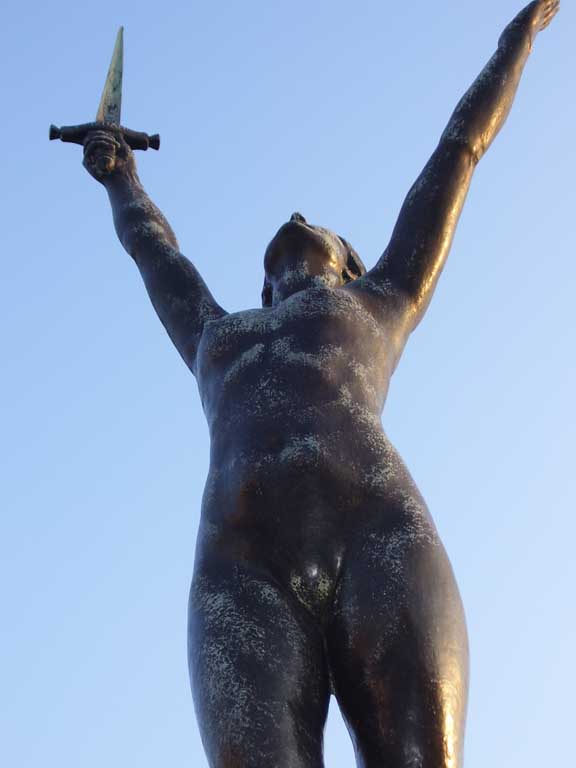
La Delivrance arches her back...

...and displays her all to the passing truck drivers
Across the slip road that feeds traffic northwards onto Finchley Road it''s no longer 1914. A plaque down the side of the United Synagogue dates its inception to the 13th Tammuz, 5712. The post-war concrete pile of the synagogue always reassured me when I was a child. Looking at its clean modern lines I knew we had reached an age of reason and all those horrid black and white war documentaries of my father''s world had passed for good. I was young and the New World was young with and for me.
Meanwhile a clump of silver birch grows on the western edge of this island of the Naked Lady. It is a fragment of the Great North-European Plain transplanted in Hendon for the benefit of the numerous immigrants weeping for Wilno, Sztutowo or Stolpemunde.
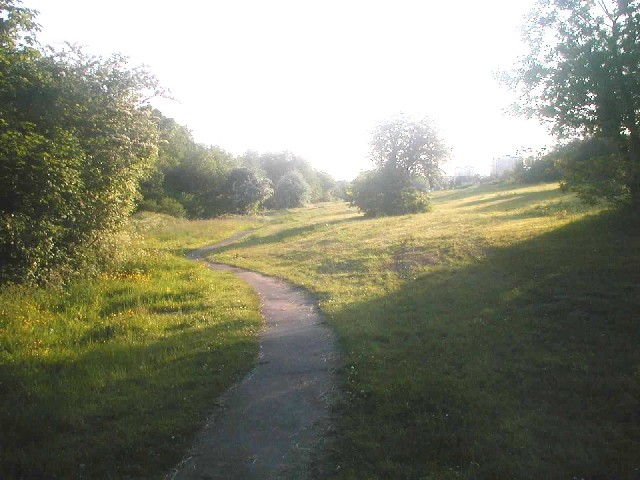
Ancient hedges alongside the North Circular Road
by Mutton Brook
At Henley''s Corner, over the A406, the old car-sales room has been smashed by Time''s 21-cm howitzer. Now there is nothing but a heap of rubble. Nearby, closer to the footpath paralleling the brook, mysterious curves and mounds indicate the presence of trunk sewers and storm-water conduits.
I turn back to the statue and, rummaging at her feet, follow a line through unkempt shrubs to a concrete channel, dry and strewn with leaves and lollysticks. At the north end of the channel two pipes jut out - they once provided the
water that spilled over the limestone blocks of the waterfall, filling the pool at the southern end. There is an elongated mound running along the grass here where a sewer cuts across to the west and aligns with the A406. Several inspection lids sport the initials FUDC and the word "sewerage".
A little along the A406 there is a large block of 1930s flats. Kinloss Court is such an icon it figures in the drawn illustrations contained in the brochure for the London Ring walking route. The curved roof section at its western end shines in the early evening mineral sunlight. It seems so uncharacteristically pleasant and languid up there on the flat top. It is easy to imagine sitting up there, drinking tequila and gazing down on the smudgy bus routes while I recline and write my next novel - a fragment of alcoholic LA in Barnet Borough.
Further down the North Circular nine-foot vertices of earth - embankments buttressing up suburban gardens against the slope of the valley of the Mutton Brook - are placed within an unmapped dead zone.
Note the plastic soft-drink bottle hidden away behind the Hawkbit and the Hairy Willow herb. How long has this object lain here? Six years? Twelve? And the twisted length of rusted metal protruding from the cracked concrete lintel woven into the wall''s fabric. What has it seen in its time? How many cars passing in their oblivion?
Crossing the successive lanes of traffic, where two major routes flow together, takes three or four minutes. Take the time than to ponder on this piece of hi-Tec road engineering. This section of the North Circular was placed in 1930. That is 74 years ago. It will therefore take you 1/9696960th of its time on Earth to date to get to the hot granite slabs of the pavement on the other side. What are you, than, in relation to this vast machine, with its curious banked camber, its memories of burned bodies, of steering wheels smeared with blood? Nothing. Certainly no more than the ants in their nests by the ditch opposite, where the path drops leading to the site of the old cress farms.
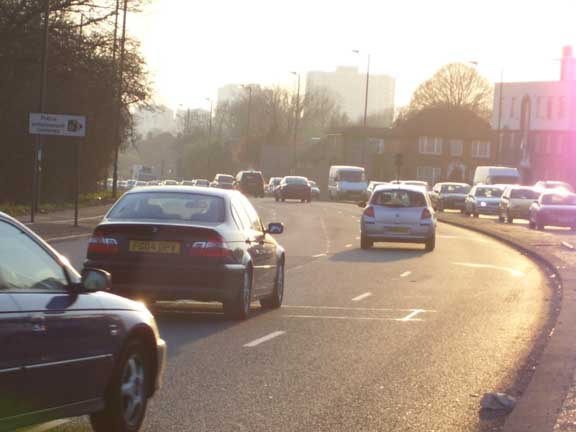
The A406, captured in the 38,683,207th minute of its existence
Yet you love it, this inhuman servant turned master, this dialectical material that continues to blindly function, all day, all night without regard for weather, change of government, our individual or mass deaths. You love it, aware of its continuous thrum while you seek out the rooks and the hoverflies of its margins. As you enter the meadows and gaze again at these relics of Old Middlesex perched on the edge of the black oiled simultaneity over yonder.
At one point hereabouts the grass has been worn away and the shiny yellow mosaic of a surface shows through. What''s this? The yellow brick road? An old County Council walkway, long forgotten? In fact it''s a high-visibility road sign which has somehow ended up buried here, in this zone of Giant Hogweed and rancid stacks of fuck-mags slung
behind the willows.

(I have learned since writing this item that the model for La Delivrance was acually a 14 year-old girl. This makes the statue illegal under current UK legislation. I therefore call upon the London Borough of Barnet to take this statue down!)
Wasps Beneath the NCR
An area of grassland runs down on a gentle slope to the river. Small yellow flowers - Birdsfoot trefoils - form a cloudy smudge in the grass while hedges cut against the slope at intervals , breaking the expanse of sward into something like individual fields. Beneath each hedge runs a ditch; these are for the most part dry in this late summer weather and are packed with willow herb and bramble. Several ants nests protrude from the meadow, the sandy domes revealing the nature of the soil, while curious horizontal platforms of concrete - each about the size of a door - stare like grey lichened tombstones through the slowly encroaching grass.
Meanwhile the heat is possibly a key factor in the harsh blaring noise emanating from several cars jammed together on the massive road system just yards away. Temporary lights and scaffolding on the new bridge take their toll on the traffic flow. It is, however, the briefest of angry eruptions; in seconds the relentless rolling will resume, the endless motorcade rumbling on to nowhere and all for nothing.
Despite the recent dryness small pools have formed where a gap in the hedge above a stretch of ditch serves as a way through to the next field. Here passing feet have cut a deeper swathe, which has retained the water left after the rains a week ago. The dense herbage all about has prevented evaporation and the pools - separated by a tiny ridge of black oozy mud crowned with a rat-tail plantain - are the only still water around.
It is here that the wasps come to drink. Several can usually be seen at any one moment, either leaning off stems of rotting grass rising above the surface of the water or sucking moisture from the grass where it has broken down into waterlogged fibres.
Over half an hour a wasp visits one particular spot - a stick poking out of the bank -three times. Her abdomen points up in the air at about sixty degrees while, leaning further forward from the thorax, she drinks deeply from the clear water. Another seems to skate on the meniscus of the water - or so I think until I notice the slender spread of grass fibres just below the surface, which serve as a platform for the wasp.
Small black flies also use the pool but no bees. I find this odd as I have seen many on the bird''s foot lotus and clover just feet away. A chequered flesh fly lands on a leaf and sups before literally reversing a half-inch and performing that curious high-speed ringing motion with its two front feet. It could almost be an anxiety reaction. Another rapid reverse places the fly at an angle to its previous position. Suddenly it is gone.
A hoverfly arrives - one of several seen over the time I sat there. The wasp-like stripes of the creature caused mass panic in Essex recently, when millions of the insects were blown over from the continent. I look closely at my specimen''s abdomen. While the broad black and yellow stripes mimic the wasps in a convincing way, the abdomen lacks the slender "wasp waist" indicative of that species. Our hoverfly has large red compound eyes and is a beautiful creature. It hovers momentarily in its geo-static orbit before hitting the water for a fraction of a second, its two wings momentarily still and revealing the "false margin" at the rear-end of the wings, caused by the outer margin of the wing venation . Soon it is up again, poised a half-inch above the water for ten seconds then down again for that briefest of drinks. This it performs several times before zipping off.
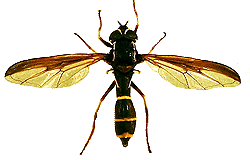
The water lice loll about as the grasses and waterlogged leaves shift gently in the pool. I poke with a stick at a tangle of fibres and fine roots and they tip over. I see a louse slide off a blackened leaf below the surface of the water and roll into the dark momentarily before appearing again, heading for the light. Another louse brushes the feet of a
wasp who flies off with an angry sound before settling once more where the mud is pitch black and stinking.
The yellow cones formed by the tapering anthers still protrude from the shrivelling bitter sweet by the ditch as I follow it down to the river at the bottom of the valley. At the crest of the slope where two major roads interlock in a series of complex junctions the traffic halts and a momentary hush settles before the queue of cars and lorries pointing in the opposite direction starts up. Down at the ditch''s lowest point, before it is fed through a pipe running under the concrete footpath, a broken web hangs between branches of blackthorn, like net curtains in the window of a problem home. Where the spider is I don''t know. Aphids and dock seeds stick in the web and may well have been there for days. Like the remains of the old cottages along the arterial road, where the road is being widened, this home is deserted.

